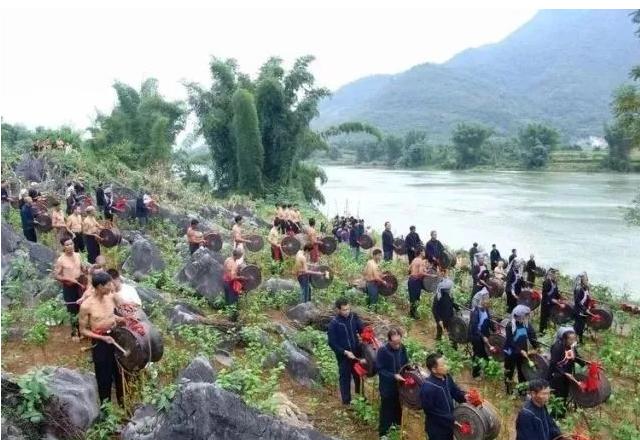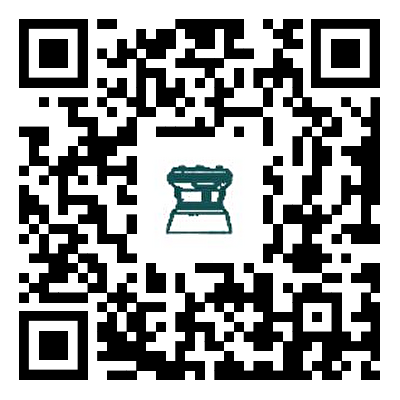东兰铜鼓舞 Donglan Bronze Drum Dance
东兰红水河一带的壮族和瑶族,至今每个传统节日、婚丧礼仪重大活动都要敲奏铜鼓。
东兰县的壮族,每当农闲之时,相邻各村的农民还喜欢聚集进行赛铜鼓。每当农历正月初一、十五、三十,将铜鼓背上附近山坡,搭好鼓架,挂起铜鼓敲打。铜鼓声传向四面八方,各村的男女青年闻声而至,找一个合适的坡顶,共同搭一个鼓棚,协商铜鼓比赛。

附近村寨,凡有铜鼓的人家都把铜鼓背上山来。每村各选出4面,公对公,母对母,按顺序轮番敲奏,每面铜鼓配3名鼓手,轮换敲打和休息,使鼓声保持持续不断。打鼓有固定节律,按“七三七”、“七单七双”、“闹斑鸠”、“倒穿行”、“小姐妹”等节律打下去。如果一方乱打或打错,就算鼓手失败,取消比赛资格。鼓声清脆响亮,打得久,打得动听,就算赢。鼓声哑了,或者铜鼓裂了,就算输。其他青年男女,一边看赛鼓,一边唱山歌。

而每当新春佳节,人们就将寨里的铜鼓集中到比较平旷的场地上,按铜鼓的大小次序,排列出一定的“音阶”,由一个熟知铜鼓音阶和声律的老鼓手敲着锣指挥,鼓手们一人一鼓,按照统一的指挥,敲出各自的鼓点,与其他的铜鼓配合,形成特有的节奏和旋律。跳舞者穿着节日的盛装,应声起舞。舞蹈的内容一般有“开场”、“春耕”、“夏种”、“秋收”、“冬藏”、“迎春”6个部分,鼓声传闻十数里之外,其他村寨的人听到鼓声,也集合男女老少抬着铜鼓来助兴,有的村寨与村寨之间展开比赛。

东兰瑶族的达努节,自古至今是瑶族人民传统的盛大节日,规模相当于其他兄弟民族的春节一样,这天,瑶寨铜鼓声声,村村寨寨,家家户户,当猪宰羊,钉鸡酿酒,染红绿蛋,蒸红糯饭,盛设家宴,亲戚朋友,欢聚一堂。男女老少,都穿上自己缝绣的民族服装,打扮得面目一新,然后成群结对地来到歌山,敲起铜鼓,吹起唢呐,唱起祝酒歌和撒旺歌。青年男女的细话歌,可以唱得几天几夜,男女互吐恋情,难舍难分。
东兰铜鼓以青铜为主配,与其它金属铸造而成。鼓形状大小不一,重量有几公斤至几十公斤。鼓面都有浮雕图案,图案中心有太阳,光芒四射。每个铜鼓的花纹都不同,有同心同纹、乳钉纹、人鱼纹、兽形纹、云雷纹。封面图案各异,有的铸有人物、畜禽、钱宝、房屋、龙凤、十二生肖像、双龙祈祷图,有的刻有祝愿吉祥的短语,诸如“万代进宝、永世家财”,“福如东海、寿比南山”等民间祝福词句。还有的是反映生产劳逸舞蹈等场面。
铜鼓全身都用铜的合金铸造,通体厚薄均匀,铸造精美,是一种造型和装饰水平很高的综合艺术品。民国以来,很多铸造专家进行了铜鼓铸造复制,但各方面都不及古代的铜鼓,铜鼓如何铸造,至今仍是个迷。


The Zhuang and Yao ethnic groups in the Donglan Hongshui River area still play bronze drums in every traditional festival, wedding and funeral ceremony and major event.
The Zhuang people in Donglan County like to gather for a bronze drum competition in neighboring villages during idle farming hours. Every time on the first, fifteenth, and thirtieth day of the first lunar month, carry the bronze drum onto a nearby hillside, set up a drum stand, and hang it to beat. The sound of bronze drums spread in all directions, and young men and women from various villages came to find a suitable slope top to jointly build a drum shed and negotiate a bronze drum competition.

In nearby villages, everyone who has a bronze drum carries it up the mountain. Each village selects 4 drums, male to male and female to female, and plays them in sequence. Each copper drum is accompanied by 3 drummers, who rotate and rest to keep the drum sound continuous. The beat of drums has a fixed rhythm, which is played according to the rhythm of "737", "seven singles and seven pairs", "noisy turtledoves", "backward crossing", "little sisters", etc. If one party plays indiscriminately or wrongly, even if the drummer fails, they will be disqualified from the competition. The drums are clear and loud, played for a long time, played beautifully, even if you win. If the drum sounds hoarse or the copper drum cracks, it is considered a loss. Other young men and women watched the drum race while singing mountain songs.

During the Chinese New Year holiday, people gather the bronze drums in the village on a relatively flat ground and arrange a certain "scale" according to the size order of the drums. An old drummer who is familiar with the scale and rhythm of the bronze drums beats the gong to command, and each drummer beats their own drum according to a unified finger wave, striking their own drum points, and coordinating with other bronze drums to form a unique rhythm and melody. Dancers dressed in festive attire danced to the sound. The content of the dance generally consists of six parts: "opening", "spring plowing", "summer sowing", "autumn harvest", "winter storage", and "welcoming spring". Rumors have it that more than ten miles away, people from other villages also gather men, women, and children to carry bronze drums to cheer up, and some villages engage in competitions with each other.

The Danu Festival of the Donglan Yao ethnic group has been a traditional grand festival for the Yao people since ancient times, similar in scale to the Spring Festival of other brother ethnic groups. On this day, the sound of bronze drums in the Yao village, the sound of villages, and every household, slaughter pigs and sheep, nail chickens for wine, dye red and green eggs, steam red glutinous rice, hold family banquets, and gather together with relatives and friends. Men, women, old and young, all dressed up in their own embroidered ethnic costumes, and then came to Geshan in pairs, playing bronze drums, playing suona, singing toasts and sawang songs. The fine talk songs of young men and women can be sung for several days and nights, and men and women can express their love for each other, which is difficult to part from.
The Donglan copper drum is mainly made of bronze and cast with other metals. Drum shapes and sizes vary, with weights ranging from a few kilograms to several tens of kilograms. The drum surface has relief patterns, with the sun shining in the center of the pattern. Each bronze drum has different patterns, including concentric patterns, breast nail patterns, mermaid patterns, animal shaped patterns, and cloud thunder patterns. The cover designs vary, with some featuring characters, livestock, treasures, houses, dragons and phoenixes, zodiac figures, double dragon prayer pictures, and others engraved with auspicious phrases such as "treasure for generations, eternal family wealth" and "blessings like the East China Sea and longevity like the South Mountain". There are also scenes that reflect the production of labor and leisure dances.
The entire body of the copper drum is cast with copper alloy, with uniform thickness and exquisite casting. It is a type of comprehensive design and decoration with high level









